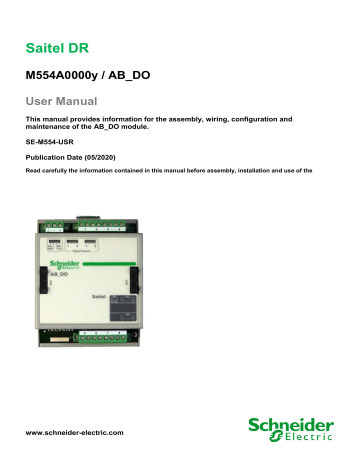advertisement

User Manual – AB_DO
3 Physical Mounting & Installing
05/12/2019
R&D Digital Seville
Pag 21
05/12/2019
Content
User Manual – AB_DO
3 PHYSICAL MOUNTING & INSTALLING ................................................................ 21
P OWER S UPPLY R EQUIREMENTS .................................................................... 23
Pag 22
R&D Digital Seville
User Manual – AB_DO
3.1 Installation
05/12/2019
3.1.1 Handling
DANGER
Depending on the devices connected, the AB_DO could have hazard of electric shock, electric arc or burns. For any of these cases, follow these instructions:
• Only qualified operator should install this equipment. Such work should be performed only after reading this entire set of instructions and checking the technical characteristics of the device.
• NEVER work alone.
• Turn off all power supplying this equipment before working on or inside it. Consider all sources of power, including the possibility of back feeding.
• Always use a properly rated voltage sensing device to confirm that all power is off.
• Start by connecting the device to the protective ground and to the functional ground.
• Screw tight all terminals, even those not in use.
Failure to follow these instructions will result in death or serious injury .
To avoid electrostatic damage, the following precautions must be strictly followed:
• Do not touch the bus connector pins.
• If unused, keep the modules in the antistatic bag.
WARNING
Electrostatic discharges may damage semi-conducive devices within the module.
3.1.2 Location in the ITB
There are not special considerations for locating this module in the ITB.
3.1.3 Power Supply Requirements
The main power is supplied by the HU through the bus. A polarization source is required for digital outputs, and the voltage depends on the ordering option.
The maximum power requirement for each AB_DO module is:
• Main power supply (through the bus): Basic consumption
• Polarization supply : 8 * Polarization voltage
*
Maximum consumption per realy 1
3.1.4 Mounting Procedure
WARNING
It is important to assure that handling is always done while the ITB elements are unpowered.
All Saitel DR modules, have a DIN-rail bracket at the rear side that allows mounting on a DIN rail:
1 Basic consumption and Maximum consumption per relay values are indicated in the technical specifications table at the end of this manual.
2 Polarization voltage value depends on the manufacturing option of each module.
R&D Digital Seville
Pag 23
05/12/2019
Figure 11 - Mount bracket on DIN rail
User Manual – AB_DO
The mounting procedure is described below:
• Switch off the power supply.
• Attach the module’s rear bracket on the upper DIN rail.
• Press the lower front panel gently until a click confirms that the bracket is fit on the rail.
• Verifying the module is anchored firmly to the rail, although lateral movement is possible.
Figure 12 Saitel DR module on a DIN rail
The module is dismounted from the DIN rail as follows:
• Switch off the power supply.
• If necessary, disconnect the bridge(s) connecting the module to the system bus.
• Holding the module by the front panel, push the upper metal tab downward. The user can also pull the tab down using for example a screwdriver as shown in
Figure 13 Remove Module
• Pressing the tab, remove the module from the lower DIN rail.
• Once detached, the module can be removed easily.
3.2 Wiring AB_DO
This module has three terminal blocks labeled as B1, B2 and B3. B2 and B3 allow the 8 digital outputs to be connected through screw terminals. B1 allow connect the external polarization source.
Pag 24
R&D Digital Seville
User Manual – AB_DO
3.2.1 Wiring Recommendations
The following table shows several wiring recommendations for signals and polarization:
05/12/2019
Type of wire
Polarization 7 mm
1.5 – 2.5 mm²
15 - 13 AWG
0.5 Nm Copper
Digital outputs 7 mm
1.5 – 2.5 mm²
15 - 13 AWG
0.5 Nm Copper
3.2.2 Digital Output Connection
Both B1 and B3 have 4 terminals for signals. The field outputs are voltage-free NO (Normally open) contacts.
Figure 14 – AB_DO – B1 and B3 terminal blocks wiring.
R&D Digital Seville
The 4 signals wiring in each terminal block is described below:
Figure 15 – Digital outputs wiring.
Pag 25
05/12/2019
3.2.3 Polarization
User Manual – AB_DO
The figure below shows how to connect the external polarization source to the B2 terminal block:
Figure 16 – Polarization wiring.
The following schematic shows the connection to field for B2 terminal block:
Figure 17 – AB_DO - B1 and B2 terminal blocks wiring.
The following figure shows how you can wire digital outputs in an AB_DO with digital inputs in an
AB_DI module.
Figure 18 – Example of wiring digital inputs and digital outputs.
Pag 26
R&D Digital Seville
User Manual – AB_DO
3.3 LED Indicators
There are 12 light indicators (LED) on the front of the module:
Figure 19 – AB_DO LED Indicators
05/12/2019
LED Status Description
Run Module working properly.
Module not in acquisition mode.
SBO
Fail
The information by the LED indicators includes:
• Acquisition and configuration status ( Run and Fail )
• Indicate that the outputs are defined as SBO ( SBO )
• Module in maintenance ( Mnt )
• Status for each digital output ( Digital Output x ).
AB_DO’s LED provide the following information to the operator:
The outputs are defined as SBO
The outputs are defined as DO
Module not configured or in abnormal state.
No fault has been detected in configuration or hardware.
Failure in EEPROM.
Recommended action
The module was not included into the configuration, the module doesn't have an address or according to the loaded configuration, the type of the module is wrong.
Check the configuration loaded in the HU. The module must be addressed and with the correct type (AB_DO).
Mnt
1..8
The module is in maintenance (Flashing, addressing, ...)
The module is in operation.
The corresponding output is active
The corresponding output is inactive
R&D Digital Seville
Pag 27
advertisement